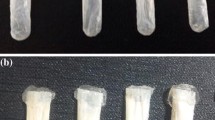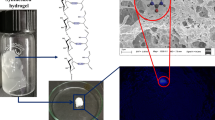Abstract
Formation of regenerated cellulose (RC) membranes from dimethyl sulfoxide and paraformaldehyde solvent system is described. These membranes were cast. on cylindrical molds using the dip coating approach. After dip coating, the molds were immersed in water, acetone and several short chain 1-alkanols to precipitate cellulose. The wet cast. membranes were then thermally treated to obtain rigid, solvent and non-solvent free membranes. The formation process of these membranes was examined under the microscope. Physiochemical characteristics of these membranes were analyzed using infrared spectroscopy and X-ray diffraction analysis. The effect of membrane hydration on solute permeability in side-by-side diffusion cells was examined under controlled hydration conditions. The effect of thermal treatment was investigated by measuring methylene blue dye adsorption on membranes prior to and after thermal treatment. Cellulose is in amorphous state in these membranes. The RC membranes poses a unique self-pore forming feature when they are exposed to aqueous environment. Solvent uptake is critical to solute diffusion through them. The pore forming capability is reversible by introducing organic solvents in the diffusion medium. Membrane formation is not influenced by the type of non-solvent used, but affects the amount of cellulose aggregation during thermal treatment. Thermal treatment can also reduce the permeability of the solute through them.











Similar content being viewed by others
References
Annadurai G, Juang R, Lee D (2002) Use of cellulose-based wastes for adsorption of dyes from aqueous solutions. J Hazard Mater 92:263–274
Chang C, Zhang L (2011) Cellulose-based hydrogels: present status and application prospects. Carbohydr Polym 84:40–52
Chen Y, Flanagan D (2009) Theory of diffusion and pharmaceutical applications, developing solid oral dosage forms. Academic Press, San Diego
Higgins H, Stewart C, Harrington K (1961) Infrared spectra of cellulose and related polysaccharides. J Polym Sci 51:59–84
Kaewprasit C, Hequet E, Abidi N, Gourlot J (1998) Application of methylene blue adsorption to cotton fiber specific surface area measurement: part I. Methodology. J Cotton Sci 2:164–173
Kamel S, Ali N, Jahangir K, Shah S, El-Gendy A (2008) Pharmaceutical significance of cellulose: a review. Express Polym Lett 2:758–778
Kataoka Y, Kondo T (1998) FT-IR microscopic analysis of changing cellulose crystalline structure during wood cell wall formation. Macromolecules 31:760–764
Klemm D, Philipp T, Heinze U, Wagenknecht W (1998) Comprehensive cellulose chemistry, volume I: fundamentals and analytical methods. Wiley, New York
Kumar V, Bhatt B (2015) Cellulose capsules and methods for making them. US Patent 9,050,264 (Jun. 5, 2015)
Nicholson MD (1976) Reaction of cellulose in the DMSO/PF solvent. Ph.D. Thesis, The Institute of Paper of Chemistry, Appleton, Wisconsin, USA
Patil N, Dweltz N, Radhakrishnan T (1965) X-Ray measurements of crystallinity and crystallite size in swollen and hydrolyzed cottons. Text Res J 32:460–471
Schroedera L, Gentilea V, Atallaa R (1986) Nondegradative preparation of amorphous cellulose. J Wood Chem Technol 6:1–14
Sczostak A (2009) Cotton linters: an alternative cellulosic raw material. Macromol Symp 280:45–53
Seymour R, Johnson E (1976) The effect of solution variables on the solution of cellulose in dimethyl sulfoxide. J Appl Polym Sci 20:3425–3429
Xing D, Peng N, Chung T (2010) Formation of cellulose acetate membranes via phase inversion using ionic liquid, [BMIM]SCN, as the solvent. Ind Eng Chem Res 49:8761–8769
Yamane C, Mori M, Saito M, Okajima K (1996) Structures and mechanical properties of cellulose filament spun from cellulose/aqueous NaOH solution system. Polym J 28:1039–1047
Yasuda H, Lamaze C, Peterlin A (1971) Diffusive and hydraulic permeabilities of water in water-swollen polymer membranes. J Polym Sci 9:1117–1131
Zhou S, Tashiro K, Hongo T, Shirataki H, Yamane C, Li T (2001) Influence of water on structure and mechanical properties of regenerated cellulose studied by an organized combination of infrared spectra, X-ray diffraction, and dynamic viscoelastic data measured as functions of temperature and humidity. Macromolecules 34:1274–1280
Author information
Authors and Affiliations
Corresponding author
Rights and permissions
About this article
Cite this article
Bhatt, B., Kumar, V. Regenerated cellulose capsules for controlled drug delivery: Part I. Physiological characteristics of membrane formation and the influence of thermal annealing. Cellulose 22, 3237–3250 (2015). https://doi.org/10.1007/s10570-015-0695-y
Received:
Accepted:
Published:
Issue Date:
DOI: https://doi.org/10.1007/s10570-015-0695-y




